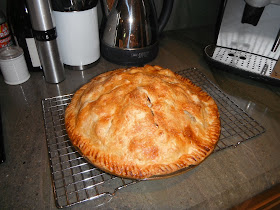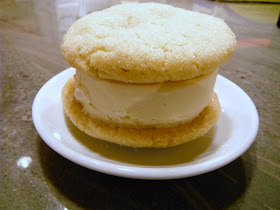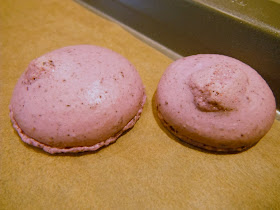Apple Pie!
When we invited my neighbor and friend over for dinner on her birthday, I knew I'd have to bake a pie. Trudi's been telling me for years that apple pie is her very favorite dessert. Luckily, I found some beautiful (and gigantic, I might add) apples at the store and I was on my way. (I should brag that I was able to peel the entire apple in one string of peel in 6 out of 8 of the apples I used. I know, I'm cool.)
I'm also testing out some new ice cream recipes, specifically some from
Jeni's Splendid Ice Creams at Home, a new ice cream cookbook that I pined for all summer and just received as a late birthday present from my brother-in-law Brian. Although I'd previously seen some of the flavor combinations in Jeni's book, I didn't realize that her recipes are not egg-based, like a traditional custard. In the past, I'd snubbed my nose at (I know, can you imagine?) those "Philadelphia-style" ice creams, but I've now opened my mind and decided that I definitely won't know until I try them. Jeni's ice cream's use starch as a thickener (corn starch or tapioca) and also add a small quantity of a liquid sweetener (she uses corn syrup, but I've subbed agave nectar), in addition to a little cream cheese.
I made two ice creams from Jeni's book this weekend (Classic Vanilla Bean and a very unique Olive Oil with toasted pepitas), either of which would go nicely with this apple pie.
So, to deconstruct this very classically American dessert, I'd like to take a few minutes to chat about pie crusts. The American style pie crust almost
always contains shortening ("Crisco") instead of, or in addition to, butter. But, this hippie chick does not do Crisco. Not if I'm planning on eating it anyway...(Hmm, lol). So, I have become a believer in pie crusts made entirely with butter. Don't get me wrong, I'm not saying that an all-butter pie crust is "healthy," but it's definitely better than Crisco and tastes SO. MUCH. BETTER. Did you know that vegetable shortening does not have any taste? The role of vegetable shortening in an American-style pie dough, though, is to repel water and create the characteristic flakiness that people want in their crust.
Guess what? There is another way. The key (and this is real valuable info I'm sharing here) to an absolutely delicious, flaky, pie dough is in the handling of the dough. Don't overwork the dough. And, most people who think they are making the dough just "come together" have already overworked it. Now, I know how good it feels to knead the heck out of some dough. But, if you want to do that, please, make bread. Basically, to paint a mental picture, if you have to scoop up little crumbs of dough that have various sizes of visible butter into your plastic wrap, you're looking at a nicely done pie dough.
The dough spends a little time in the fridge, just to firm up and make certain that the butter doesn't become too homogeneous in the dough when it's being rolled out. Once it's been rolled out, it's usually a good idea to put the pie in the fridge again (or even freezer for 10 minutes or so), just to make sure that those visible chunks of butter" stay in chunks when it hits the hot oven. This has the effect of immediately melting the butter, which releases water as steam, which rises those pieces of dough into the air so they can hit the heat and brown. Thus, your flaky, American, all-butter pie dough. See, that wasn't so hard. Just remember not to work the dough too much.
While the crust is chilling, you can make your filling. Like I said above, I selected 8 gigantic apples (4 Granny Smith and 4 Fuji, a mix is always nice), peeled them and removed their cores. (As an aside, my favorite way to remove the core is by using a melon baller once the apple has been cut in half. It gets that core out nicely and you don't loose valuable apple.) I slice each apple half into 8 wedges, then cut each of those wedges in half. Apples contain a lot of water, so when they bake, they will settle within the pie, Making the slices smaller and uniform like this helps keep the height of your pie as predictable as possible. (Another thing you could do is bake the apples in the oven in advance to release the water, or you can place the sugared apple slices in a sieve for an hour or so before you construct the pie. Same outcome.) But, I kinda like all that yummy liquid that comes out in there and, as long as you make your pie crust thick enough and bake it long enough, it should still stand up to the liquid.
So, put these apples in a big bowl (huge), add the zest and juice of 1/2 lemon (about a tablespoon). In a separate bowl, mix about 1/2-3/4 c sugar with 2 T flour, 1 t salt, 1 t cinnamon and about 1/4 t ground nutmeg. (I always grind my own. If you buy whole nutmeg, you can grind it using your lemon zester and the unused nutmeg goes right back in the can for the next time you need it. One nutmeg lasts me a long time and would probably last you even longer.) Mix these dry ingredients in with the apples, making sure that all slices get coated.
**If you like lots of spice, you could definitely add more of either of these or experiment with adding allspice, ginger or even other ingredients to your mix (raisins, cranberries, toasted nuts, etc).**
When you are ready to roll out the dough, set the oven to a high temperature of 500°F and place a cookie sheet on the bottom rack. Remove one disk of dough from the fridge and roll it out on a lightly-floured counter until it's a few inches larger than the diameter of your pie pan. I used a 9" pie pan, so I rolled the dough to about 13" to allow for the sides and a little overhang. Place your apple filling in the crust, then put this in the fridge while you remove and roll out the second piece of dough. The second/top piece can be rolled slightly smaller, I went to about 12". Remove your pie from the fridge, place the second piece of dough on top and press the edges of the 2 crusts together, folding them under along with any overhang. You can crimp the edges using a fork or your fingers.
Provided your oven is at temperature and your pie is still cool, you can pop that sucker in the oven immediately. Like I said earlier, if you need to refrigerate or freeze it for 10 minutes, that's fine too. Just before putting it in the oven, brush the crust with egg white and sprinkle with sugar. (I used demarara sugar or coarse sugar.) Place the pie on the preheated cookie sheet, close the door, then immediately turn the temperature down to 425°F.

Bake at 425°F for about 25 minutes, or long enough to get a beautiful brown color developing on the crust. Once it's nicely browned, again decrease the temperature to 375°F and bake for another 35 minutes or so.
Remove from the oven and allow to cool on a wire rack for a few hours before serving.

All Butter Pie DoughYield: one double pie crust (or two singles)
2 1/2 c flour
1 T sugar
1 t salt
8 oz cold, unsalted butter, cut into small cubes
ice cold water
Whisk the flour with the sugar and salt in a large bowl. Sprinkle cubed butter over the dry ingredients and use your hands or a pastry blender to work the butter into the flour. Continue to work until remaining butter is pea-sized pieces. Do not overwork or overmix the dough. Gradually add ice cold water to the mix (start with ½ cup and plan to add another 2-4 Tsp beyond that). Stir in the water just until the dough begins to come together. Gather the dough, divide it in half and wrap each half in plastic wrap. Chill in the refrigerator for at least an hour, but can be stored for about a week.
Apple pie is really not complete without the "a la mode," so now I'm going to talk about ice creams.
There are 2 styles of ice cream, French style and American or Philadelphia-style. The French style of ice cream involves making a custard by cooking milk and/or cream and tempering egg yolks with the hot mixture. This addition of the hot liquid to the egg yolks stabilizes the mixture and creates a thickening reaction when cooked over more heat. Because of this, ice creams made using the French custard method tend to be richer and silkier. The amount of egg yolks, as well as the milk/cream ratio, vary tremendously among recipes. Most recipes will tell you to use whole milk, but I've found 1% to be perfectly adequate. There are a couple of potential downsides to this method. First, since most people are not used to cooking a custard over heat, there is a reasonable likelihood that the custard may get overcooked or curdled. Sometimes the ice cream can be saved after pushing the custard through a fine-mesh sieve, but sometimes not. My advice on this is just to cook the custard slowly at first until you get the hang of when and how it thickens. Oh, and stir constantly at that stage. Second, since custards are, by definition, HOT, the resulting mixture will need to undergo significant cooling before you can freeze it in your ice cream machine.
The American or Philadelphia-style of ice cream isn't made with eggs at all. Usually just a mixture of milk and cream, with sugar and flavorings, perhaps some additional thickeners, this ice cream can be made in a fraction of the time of a traditional custard. In the past, I'd heard that these ice creams tasted as if they were missing something and that the texture was different than a standard ice cream. Not so with Jeni's recipes. I don't know if it's the cream cheese or the starch, but the consistency of the two ice creams I made was beautiful! And the taste, outstanding! As I mentioned above, I didn't really want to use corn syrup, so I substituted agave nectar which worked fine. With the olive oil ice cream, the amount of cream is reduced, since the mixture gets some fat from the oil. Oh, and pepitas are pumpkin seeds, shelled. If the ones you find are not toasted or salted, you can just toast them in a skillet over medium heat with a little olive oil, then salt them and cool.
Vanilla Bean Ice Creammakes about 1 quart
2 c milk
1 T + 1 t cornstarch
1.5 oz cream cheese, softened
1/8 t fine sea salt
1.25 c cream
2/3 c sugar (I use less, about 1/2 c)
2 T light corn syrup (I used agave nectar)
1 vanilla bean, split in half and seeds scraped out
Mix about 2 T milk with the cornstarch in a small bowl to make a slurry. Whisk the cream cheese with salt in a medium bowl. Cook the remaining milk, cream, sugar and corn syrup, along with the vanilla (+ bean pod) in a saucepan over medium-high heat. Bring to a boil and boil for 4 minutes. Remove from heat and add the cornstarch slurry. Bring back to a boil and cook until slightly thickened, a few minutes. Remove from the heat and whisk into the cream cheese until smooth. Cool your mixture in an ice bath (submerge in a larger bowl with ice and water) until cool. Remove the vanilla bean pod before spinning in your home ice cream machine.
Olive Oil Ice Cream with Sea-Salted Pepitasmakes about 1 quart
2 c milk
1 T + 1 t cornstarch
1.5 oz cream cheese, softened
1/4 t fine sea salt
1 c cream
1/2 c sugar
2 T light corn syrup (I used agave nectar)
1/4 c olive oil
1 c salted roasted pepitas

Mix about 2 T milk with the cornstarch in a small bowl to make a slurry. Whisk the cream cheese with salt in a medium bowl. Cook the remaining milk, cream, sugar and corn syrup, along with the vanilla (+ bean pod) in a saucepan over medium-high heat. Bring to a boil and boil for 4 minutes. Remove from heat and add the cornstarch slurry. Bring back to a boil and cook until slightly thickened, a few minutes. Remove from the heat and whisk into the cream cheese until smooth. Whisk in the olive oil. Cool your mixture in an ice bath (submerge in a larger bowl with ice and water) until cool. Spin in your home ice cream machine. Layer the pepitas in with the ice cream as you spoon the mixture into containers for freezing.






























